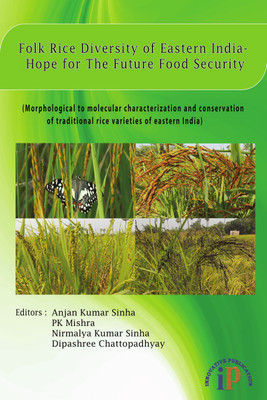Folk Rice Diversity of Eastern India-Hope for The Future Food Security(English, Paperback, Anjan Kumar Sinha, PK Mishra, Nirmalya Kumar Sinha, Dipashree Chattopadhyay)
Quick Overview
Product Price Comparison
Rice (Dhan, Chabal) belongs to the genus Oryza (Family- poaceae, 2n=24) is the staple food for more than half of the worldŌĆÖs human population. It is consumed as staple food for about 3.5 billion people across the whole world. Genus Oryza consist of two cultivated species O. sativa and O. glaberrima, and 23 wild species. Among the two cultivated speices O. sativa was dominated in Asian as well as Europe, South America region and O. glaberrima was mostly concentrated into the West African countries only. The Asian rice O. sativa was evolved from wild perennial O. rufipogon and wild annual O. nivaraand wild progenitors of O. glaverrima was O. longistaminata and O. breviligulata. According to Normille (2004) Oryza sativa was first domesticated between 8000-15000 years ago in India and China and river valleys of Yangtze, Mekon rice could be the primary Centre of origin of O. sativa while delta of Niger river in Africa is the primary Centre of origin of diversity of O. glaberrima. Among Asian countries rice production as well as consumption is highest whereas in Sub-Saharan Africa, Caribbean and Latin America, rice consumption is steadily increasing. Rice alone provides about 50% of the dietary caloric supply in around 520 million poor people in Asiatic countries. Rice is grown in 160.6 million hectares across the world with the total production of 738.20 million tones having productivity 3424.41 kg/ha (FAO, 2015).India is the Centre of origin of Rice and it is also the second largest producer of rice just after China. Thousands of ecospecies of rice had been evolved in India from the down of crop domestications. The ecospecies of japonica, indica and javanica have been generally recognized in O. sativa. Numerous rice landraces had been evolved due to random mutations and selection by the ancient farmers since centuries of rice domestications. India has a vast agroclimatic environmental conditions which gives suitable platform for tremendous genetic diversity. National Bureau of Plant Genetic Resources (NBPGR) and International rice research institute (IRRI) have been recorded and maintained more than 60,000 rice landraces of Indian subcontinent still now. India is popular for its native wealth of rice genetic resources and among these the large number of indigenous short grained, scented varieties cultivated in different pocket of various states of eastern India. Chhattisgarh popularly known as ŌĆ£Rice Bowl of IndiaŌĆØ and two other states namely Odisha and West Bengal have a significant amount of diverse rice germplasms.


